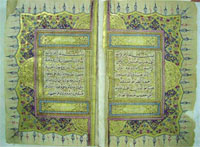
Al-Ahqaf manuscript library preserves Islamic history and learning [Archives:2008/1176/Culture]
July 28 2008
 |
 |
[email protected]
The Al-Ahqaf Manuscript library is a unique jewel for us, carrying a reflection of the learned people that have come before us. It is upon us to work and to re-establish the organization of this inheritance so that it might become clear in the hearts and in the books, according to Abu Bakr Ibn Ali Al-Mashhur, Islamic scholar and founder of numerous Islamic institutions.
This library was named Al-Ahqaf in reference to the old name of the Hadramout valley, as it was called in the Holy Quran in the Sura of the same name. It was established in 1972 by the Endowment for Private Libraries by the following individuals and their families: Umar Ibn Ali Al-Junaid and his brother Ahmed, Abdullah Ibn Umar Ibn Yahya, Hussein Ibn Abdul Rahman Ibn Sahl and Al-Kaf family. The Al-Kaf library comprised the collections of Al-Kaf and Al-Husseini libraries, which originally belonged to the literary scholar and historian Saleh Ibn Ali Al-Hamed.
The administrator of these libraries thought to make them one in order to facilitate reading and research while simultaneously easing maintenance and care. The Ministry of Culture took charge of the administration and upkeep of this library. They later passed this task on to the Yemeni Center for Cultural Research, Museums and Archeology. In the early stages of setting up the library, there were some printed materials mixed in with the manuscripts and it was deemed necessary to separate one from the other. To accommodate these, the Al-Ahqaf Library for Printed Matter was established. Subsequently, the decision to make the Al-Ahqaf library the main library for manuscripts in the country was thought of by the Minister of Culture for the government of South Yemen before the unification. About 200 manuscripts were added to the Al-Ahqaf library. Most of these came from two places; 80 came from the Sultani library in Al-Mukalla, and another 50 came from the library of Sheikh Al-Amoudi Ibn Shubat Ba Muhammad of the Amd valley. The remainder came from a number of different sources.
The Al-Ahqaf library has several departments, including the department of manuscripts that contains some 6,200 manuscripts arranged in cupboards according to subject: Qur'anic exegesis, Prophetic traditions, jurisprudence, Sufism, biographies and history, language and literature, medicine, and assorted collections (manuscripts containing more than one subject). Most of these manuscripts go back to the 10th and 11th century after Hijrah. Among them are rarities like an edition of the Qur'anic exegesis by Al-Bayaan by Abu Jafar Ibn Muhammad Ibn Al-Hassan Al-Tusi and the second part of a medical text by Ibn Sina (Avicenna). This edition was copied in 633A.H. and contains margin notes that were copied from the author's edition.
Other departments include the Department of Printed Materials, which contains references related to the manuscripts and indexes for some world libraries, the Department of Computers and Photocopying and the Department of Maintenance, which has materials and equipment for bookbinding and restoration.
Due to the great cultural inheritance it comprises, the Al-Ahqaf library must serve researchers and students coming from different foundations and governments as well as private and foreign universities who come to check manuscripts or do research. Ahmed Al-Jifry, a student at Dar Al-Mustafa, an international center for Islamic studies, came to the library to check a manuscript on jurisprudence. \”I always come to the library to see what our predecessors handed down to us. I am very proud to find a library like this in my country


